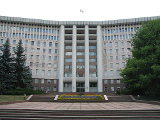Moldova: No Revolution this Time Around
2009
By Diyar Autal for ISN
On 7 April, the day after the announcement of the results for Moldova’s parliamentary elections, thousands of young protesters took to the streets of the capital Chisinau, fighting with police and ransacking the parliament over what they saw as rigged elections.
The protests have sparked a debate among politicians and media in the former Soviet Union as to whether the events in Chisinau represent another link in the chain of so-called "color revolutions."
Mass protests by opposition forces unhappy with official election results and accusing the authorities of falsification began long before the first “color revolution” in Georgia in November 2003.
Following presidential elections in Armenia in 1996, an angry mob forced its way into parliament, beating the vice speaker and looting the building. The opposition in Azerbaijan organized mass protests after the presidential elections in October 2003, which were violently put down by security forces.
What was common among these protests as well as those that actually led to revolutions was that the streets and squares were full of the disillusioned - people disappointed by the official election results, perceiving them to have been rigged in some way. Those suspicions were often instigated by opposition leaders who had managed to take control of the protests and direct them against the authorities, and by western election observers who often found the voting process to have fallen short of democratic standards.
The mass protests that did lead to “color revolutions,” however, had certain distinctive attributes. The revolutions in Georgia in 2003 and Ukraine in 2004 were well organized, with youth groups at the center. The Georgian “Kmara” and Ukrainian “Pora” youth groups played extremely significant roles in politicizing and mobilizing the younger generations, encouraging them to stand up for their rights. Both organizations were inspired by the example of Serbia’s “Otpor,” which was instrumental in overthrowing the government of Slobodan Milosevic in 2000.
The events that have so far led to “color revolutions” unfolded gradually, with protests continuing for weeks and the number of protesters growing as people from the provinces joined in until at some point the governments were paralyzed and unable to resist the public outcry. Each time, the protests were sustained for a significant period of time by being managed from a single center formed by a united opposition with a clear aim of toppling the regime.
In both Georgia and Ukraine, the revolutions brought to power pro-western governments that announced EU membership as their ultimate foreign policy objective.
What happened in Chisinau does not fall into the established format of “color revolutions.” There was no sustained protest that lasted for weeks; there were no youth organizations or political party leaders orchestrating the protests; and election observers did not find much fault with the polling process.
The attack on government buildings was started by a crowd that separated from the peaceful demonstration on 7 April. The opposition leaders appeared to have no control over the demonstrators who plundered and set fire to the buildings.
Though unusual for the states of the former Soviet Union, the Organization for Security and Cooperation in Europe (OSCE) recognized the elections in Moldova as free and fair.
So where does that leave us?
Natalya Moral, head of the Think Moldova NGO, believes that the communists included 180,000 “dead souls” on the voter lists, while tens of thousands of people exercised multiple voting for the Communist Party.
Indeed, elections in the former Soviet Union (with the possible exception of the Baltic states) are very delicate procedures. They are a regular cause of instability and their end result is often unpredictable. The irony of such elections is that in seeking to minimize their unpredictability and ensure the necessary result, authorities resort to “administrative resources” or blatant falsification, which only augments the prospects of discontent and thus breads unpredictability.
Suffice it is to say that there was only one case in the last decade in the countries of the former Soviet Union (again, excluding the Baltic states) in which an election brought about a regime change – and that was in Moldova in 2001. In all other cases, the authorities ensured the necessary results by controlling the media, baring candidates from running or falsifying the results. Even those elections that did end with “color revolutions” were initially announced as won by the authorities or candidates favored by the establishment.
The demonstrations in Moldova had much in common with endemic protests that often follow elections in the region; however, the established attributes of successful “color revolution” are lacking here, and the protests are not likely to produce any lasting change.
Whether or not the elections in Moldova were fair or otherwise, the violent demonstrations illustrate an essential lack of trust in the process itself, which is so common to the states of the former Soviet Union. Twenty years after the fall of the Berlin wall, free elections, taken for granted in the rest of Europe, are still merely imitated by some regimes east of Berlin. Here, elections assume the role of legitimizing the current regime rather than giving the citizens a chance to make a free and informed choice.
So for now, elections in Moldova and the protests they produced are sadly lacking in color.
